Recruitment Software You'll Want To Use
Spend more time with people, not processes.
Designed for the recruiter experience
We make software that recruiters LOVE to use.
Success follows.
Surface your best candidates
With just a few clicks, JobAdder’s powerful, automated search capability helps you uncover the right talent.
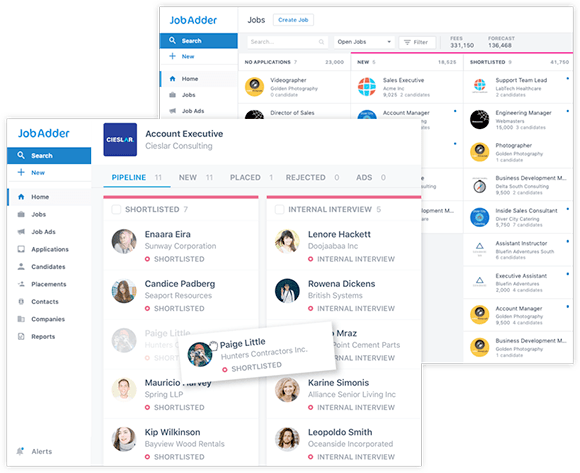
Hit the ground sprinting
Customised workflows and built-in job posting that makes recruiting intuitively easy.
“I would say we’re 2-3 times quicker getting to market now than we have been previously. Our ad posting is saving us a huge amount of time. We’re getting back 200 minutes a month.”
Courtney Chambers, Strategic Sourcing Specialist at OnTalent – read more
A clear path to success
Create structure and optimise recruitment workflows for all users to follow with Activities. Customisable forms that ensure consistency from new starter to old hand.
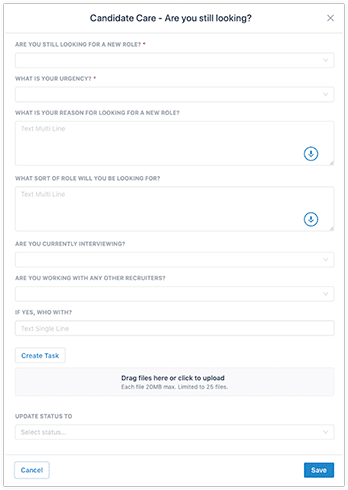
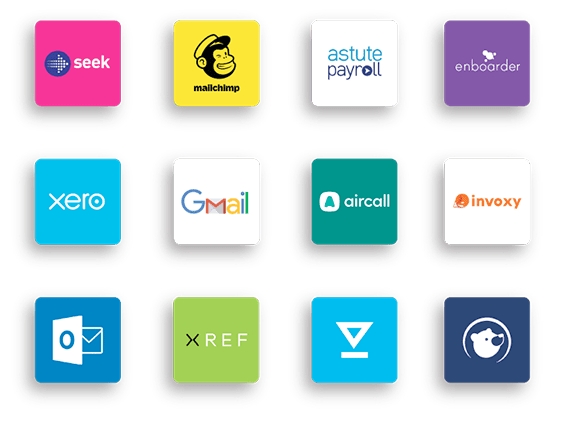
Integrations you already use
Can’t do without your referencing or payroll software?
Bring them with you. Seamless integrations mean you get, and stay, in the flow.
“has enabled us to actually implement different strategies and activities that we want to do.”
Giles Keay, Managing Director at Consult Recruitment – read more
The #1 rated recruitment app*
An app that allows you to recruit on the move? Now that’s convenient. Plus if you’d rather talk than type, voice-to-text functionality captures information 20% faster.
Read more about recruiting on the go >
“I would say we’re 2-3 times quicker getting to market now than we have been previously. Our ad posting is saving us a huge amount of time. We’re getting back 200 minutes a month.”
Courtney Chambers, Strategic Sourcing Specialist at OnTalent – read more
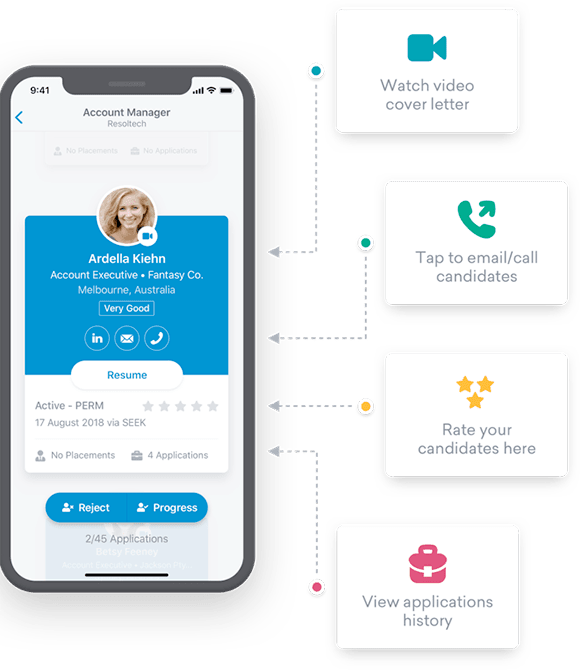
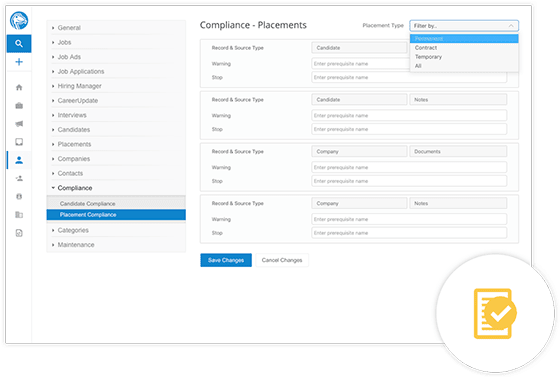
Compliance on your terms
Configure compliance fields based on the type of role you are filling. You’ll soon be able to drill down to job-specific compliance.
Workflows that work for you
Base your workflows on placement type, user groups or industry. Set hiring stages that help your consultants bring out their best performance.
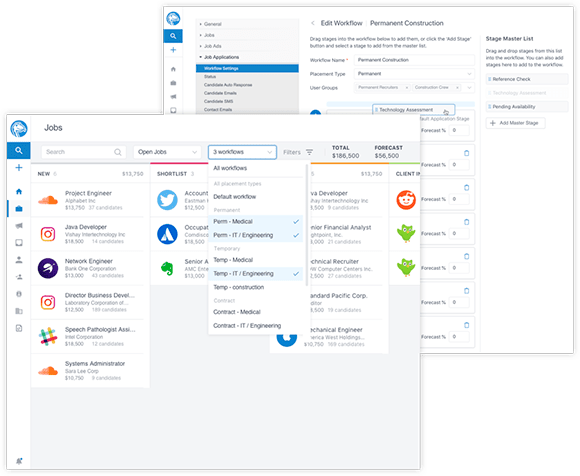
Trusted by the best recruiters


"JobAdder - finally a solution!"
We uncovered an ATS called JobAdder out of Australia. Not so well known in North America yet – but they will be.
Bruce M
Small-Business (11-50 employees)
"Loyal to JobAdder since 2010!"
The simplicity of using it – you can get up and running very quickly as it’s so intuitive. It’s fantastic value to use.
Helen C
Mid-Market (51-200 employees)
"Easy to use recruitment database"
JobAdder is easy to use and they’re always developing relevant improvements. Out of the 5 other recruitment systems I have used, JobAdder is my preferred.
Derek D
Enterprise (1,000-5,000 employees)
Talent acquisition doesn't have to be so hard
We make recruitment software that in-house teams LOVE to use.
Success follows.
Loop in your hiring managers
Automate your approval process and keep everyone on the same page.
“It’s been great to provide visibility of the recruitment activity to hiring managers and be a single location for their recruitment needs.”
Matt Baker, Manager, People, Projects at Bolton Clarke – read more >
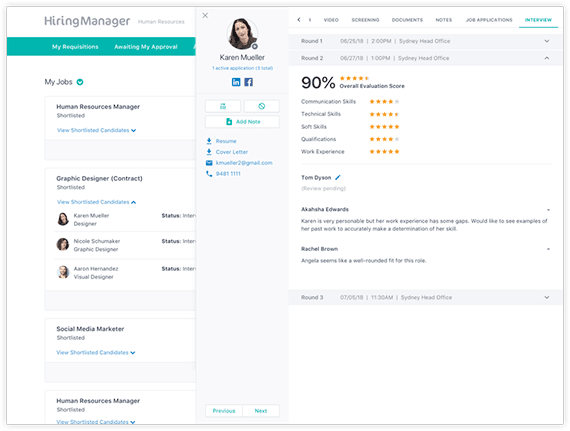
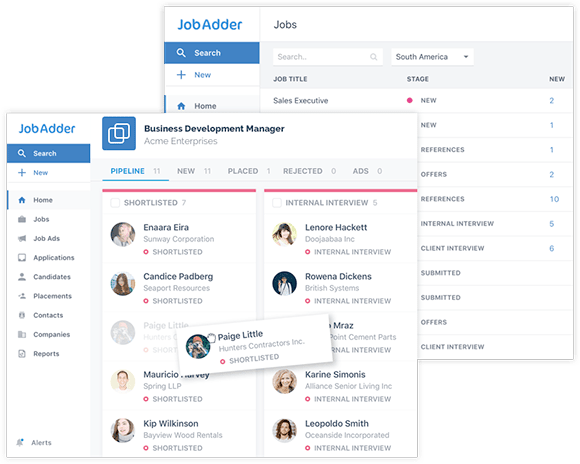
Take control of your database
Reduce time to hire by getting the right people in front of the right people. Fast.
“Time to hire is significantly less than what it was before, which ultimately is cost-saving across the business.”
Ravi Depala, HR Business Partner at Winning Group – read more >
Bring your HR tools with you
From workforce management to onboarding, make your great first impression last.
Find your favourite integration >
“If you were trying to sell JobAdder to someone and they came and asked me for my opinions, integrations would definitely be high on that list.”
Samantha Robertson, Head of HR (People & Culture) at Seafolly – read more >
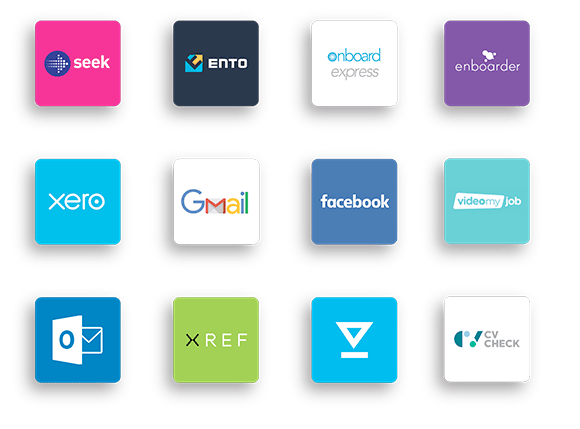
Trusted by the best in-house recruiters
Recruitment Software
What Is Recruiting Software?
Recruitment software is almost as much of a “must-have” for businesses these days as dedicated telephone lines or websites; what once seemed like a luxury or perhaps an unnecessary expense for a business is steadily becoming a necessity for many, streamlining the recruitment process in ways that once would not have been possible.
This is not to say that recruitment software replaces the “human” function in human resources; no one has designed an AI module (yet!) that also effectively interviews candidates. However, sophisticated recruitment software does create numerous ways for businesses to save time and resources when these interviews take place.
Hiring managers who are freed up from the tedious paperwork of antiquated systems are better able to focus on the important hiring decisions rather than all of the minutiae associated with job postings and talent acquisition. And savvy software systems help managers make better decisions, thanks to added consistency to the interview process, thoughtful ranking systems, and more.
If you are unfamiliar with recruiting software, we will walk you through what it is, how it will benefit your business, what features you need to consider before integrating it, and the market trends to be on the lookout for when shopping different recruitment software systems.
What Is Automated Recruitment Software?
Recruitment software describes a software system that acts as an all-encompassing tool to streamline and optimise the hiring process across an organisation.
And if that sounds like business jargon to you, let us consider it another way: most hiring managers also have an actual “job” to do, especially in businesses where budgets are tight and extra resources are scarce, or HR departments are non-existent.
Suppose that the hiring manager’s job is quality control on a production line. Suppose that manager is suddenly faced with hiring a new team member for the production line.
In that case, she will be bogged down by hours’ worth of recruitment tasks: from placing advertisements to screening job applicants and scheduling interviews.
Then, who is managing quality control on the line? It is a great burden for many businesses when recruitment efforts come at the expense of quality and productivity and—ultimately—profits.
Recruitment software does not replace the human element completely. Still, it does aid that hiring manager or recruiter with useful tools to save time and improve the overall experience, both for the manager as well as the job applicants. We will dig in below to learn more about how recruiting software systems work.
Recruiting Software Functionality and Features
What Features Does Recruitment Software Include?
Listed below are three primary features that most systems include. However, this is by no means an exhaustive list when it comes to all of the ways a recruitment software system can help you in assessing job candidates and attracting top talent.
These software systems are constantly improved to give organisations the optimal level of support when it comes to timesaving and automation in the recruitment process.
Feature 1: The Automation of Tasks
The tasks associated with the recruitment process are time-consuming, any way you slice it. Automation is key for busy hiring managers who do not want to be bogged down in this process, especially when they have their “actual” daily job to do. And the best systems allow you to customise what tasks you want to automate.
Not all businesses are alike, and their recruitment needs will not always fit in the same neat box. Therefore, a recruitment software system with customisable choices for the end-user is key.
Feature 2: Analytics and Reporting
The recruiting process is multi-layered, and at any one time, the hiring manager and other members of the company may want to see exactly where the process stands.
An effective recruiting software system will come with recruitment analytics and reporting measures that can be viewed easily in a user-friendly dashboard (and one that is accessible across the relevant managers in the company).
From how many candidates have been contacted, to how many interviews have been conducted, the recruitment software should be able to produce up-to-the-minute data for users.
Feature 3: Ease of Use as a Standalone System as Well as with Other Software
The recruitment software system you choose for your organisation should be user friendly in two ways: it should be an intuitive standalone system that a user can master quickly, with automated data entry for example, and it should also integrate easily with other software systems your business currently uses.
The best recruitment software system in the world becomes almost useless if you cannot integrate it with the data systems and platform you already use, so compatibility with other software is one of the most important features to consider.
What Steps in the Hiring Process Does Recruiting Software Manage?
From soup to nuts, the recruitment software system manages every step you will take in the hiring process. And this goes beyond the hiring process as recruitment software can and should be used to manage the onboarding process for successful candidates as well. After all, what good is investing in recruitment if you are not also simultaneously investing in retention? Bringing a talented candidate onboard with the same polished and consistent approach they witnessed in interviewing is the first step to keeping and nurturing talent, rather than losing it to competitors.
From the moment you post vacancies to job boards or social media, every step of your candidate sourcing will be assisted by the recruitment software tools. HR professionals and hiring managers can manage their various job openings and candidate sourcing through one streamlined system, which ensures time is effectively spent and hiring decisions are made in an organised fashion (versus time wasted and last-minute decisions made under pressure or with bias).
The steps in the hiring process your recruiting software can manage include:
Candidate Sourcing
Any hiring manager knows how difficult it can be to find the right candidates to fit the right roles within an organisation. Recruitment can be especially challenging when there is a limited talent pool vying for a particular role, and this is where sourcing comes in to play.
Candidate sourcing is about making a role known to ALL qualified individuals whether they are actively looking for employment or if they are what is known as a “passive candidate:” someone who may be convinced to apply for the position once they are made aware of it., even if he is not actively job seeking at the time.
Candidate sourcing within recruitment software helps hiring managers track and manage contacts with passive candidates, measure engagement, share individualised and branded web and social campaigns, and more.
Candidate Applications
Before the days of sophisticated recruitment software, managing candidate applications and resumes could be a tedious and time-consuming task for hiring managers. Talent acquisition is greatly enhanced by streamlining the application process through software.
Plus, it ensures consistency in the way candidates apply. While a singing telegram at your office door may make a candidate “memorable,” the reality is we need an accurate and measurable playing field in our first assessment of the talent pool.
When candidates are funnelled through the same recruitment software, we save time in the application process and create an organised way to rate and rank the candidates’ relevant qualifications for the job.
Additionally, application processes aided by software can be much quicker than manual ones (which can be a turnoff for candidates). A passive candidate may see your opening, have her interest piqued, but quickly pass on it if the application process seems too laborious.
A quick and effective application process managed by recruitment software could make the difference in the right person for the job applying for it instead of giving it a pass.
The Interview Process
Another way recruiting software systems save precious time and energy for hiring managers and HR teams is by streamlining the interview process. This step alone is why such software is considered a recruiting solution for so many organisations; interviewing is a time-consuming and costly process, so anything that can be done to make it easier and more efficient is truly a win for any company of any size or industry.
Recruitment software systems are built with smart interviewing in mind: they allow you to automatically update calendars when interviews are scheduled, communicate with the candidate pool in branded e-mail templates, utilise interview question kits and ranking systems, and more.
Candidate Assessments
Scorecard functionality within recruiting software enables hiring managers and HR professionals to move beyond “gut decisions” and make appointments based on actual ranked data among the talent pool.
Having sophisticated metrics and ranking systems means that managers are equipped to make the best possible decisions for their teams. Analytics and reporting can churn out data across a wide range of candidates and quickly rank them based on important metrics, removing much of the unfortunate bias that can cloud decision making in hiring.
Onboarding the Candidates
The real beauty of recruitment software is that it does not have to “end” when the offer letter is signed. A truly robust software system will also include steps to onboard the employee into the organisation, ensuring that key elements of training are not overlooked (which in the long run plays into retention and job satisfaction).
At this point, we should also clarify that there is another type of system you will encounter as you research recruitment software systems—something known as an applicant tracking system (ATS).
While an ATS is an extremely valuable business tool (and you can read more about them here, it is just one component of an overall recruitment software package.
The ATS manages the candidate’s application and interview process, whereas the recruitment software package is a more all-encompassing approach.
Benefits of Recruiting Software
How can recruitment software impact your business?
Recruitment software is absolutely transformational for many organisations in terms of time management. Streamlining the recruiting process and reducing the number of human hours spent on talent acquisition, means more time for a business to spend on increasing productivity and ultimately increasing profits.
Recruitment software will improve the way you recruit, the way you hire, and ultimately the way you retain employees. This is why a high-quality recruitment software package will more than pay for itself in the long run.
By implementing this recruiting tool, your business’s HR function can focus more time and energy on the retention of your existing talent pool, minimising turnover and time spent on recruiting in the first place.
What are the benefits of recruitment software?
The benefits of recruitment software are numerous, and ultimately the way your organisation will benefit may differ to another company of a different size, location, or industry.
However, there are some universal benefits, whether you are an organisation of 100 or 10,000 and whether you are manufacturing widgets or selling vitamins or building massive skyscrapers.
The primary benefits of implementing this kind of recruiting tool are:
- Time saved through numerous automated processes, creating more time spent on other areas of the business, such as productivity and other ways to drive up profits.
- Consistency in systems used to source, assess, and onboard candidates.
- A passive candidate pool built for future vacancies or openings within the organisation.
- A system that allows for transparency across an organisation so that all stakeholders are engaged in the recruitment process.
What are the features of recruiting software?
While the specific features are dependent upon the brand of recruitment software you ultimately choose, most come with these universal features:
Task Automation
From branded e-mails to potential candidates, to interview scheduling, to reports shared with department managers across a business, task automation is the primary feature of recruitment software that makes it such an attractive solution for HR professionals or hiring managers.
Tasks that were once managed inconsistently or haphazardly across departments, with key steps being missed or valuable talent acquisition opportunities overlooked, can now be managed through a sophisticated software system instead.
Reporting and Analytics
Another huge benefit in terms of recruitment software features is the reporting and analytics options, which allow a hiring manager to monitor progress on candidate sourcing for open positions and also make sound hiring decisions.
Recruitment software systems can churn out data instantly on where candidates measure up against the required qualifications for the job, instead of hiring managers relying on a “gut instinct” that may be swayed by an unfair bias.
Customisation Options
The best software is the kind you can customise to meet the needs of your business, and a robust recruiting software package will most certainly include customisation options.
Such options enable you to tailor branded e-mails to your candidate pool, raising their awareness of your corporate brand and impressing upon them a polished and professional presentation from the start. Customisation options make your recruitment efforts feel more personal and less canned (even if they are automated).
How can hiring data optimise your recruitment budget?
Recruiting software systems are multi-layered tools that do not “stop” when the candidate is successfully placed in a role in your organisation. These systems ultimately become reservoirs of hiring data and your best and most valuable resource in terms of planning for the future.
By collecting and storing data each time your organisation hires for a new position (or backfills a vacated one), HR professionals will have access to this valuable data when planning budgets for recruitment.
For previous positions filled, a hiring manager can easily determine:
For previous positions filled, a hiring manager can easily determine:
- how many candidates applied
- how many candidates were interviewed
- what percentage of candidates overall met the basic threshold of qualifications required for the position
- what percentage of candidates exceeded the requirements
- what percentage of candidates were passive
- how many external advertisements were placed and how many direct e-mails were sent
- what percentage of traffic to the candidate pool was driven by social media
And more….
When you have this kind of thorough understanding of what is involved with a recruitment effort for a specific position, you can begin to create a model for hiring that position in the future and attach a specific monetary amount to that effort.
Additionally, by keeping records of all candidates who have applied for positions in the past, you may be able to quickly fill vacancies in the future, rather than going back to the drawing board each time.
What Type of Buyer Are You/What Are You looking for in Recruitment Software?
What should you look for in a recruiting software package?
Because the primary benefit your organisation will enjoy with recruiting software is automation, you should look for a program that automates as many tasks as possible, while also working seamlessly with your own systems already in place.
The best recruitment software will enable you to cut down on time spent sourcing candidates, communicating with them, interviewing them, and onboarding them. All of this time saved ultimately boils down to automation.
In the past, your only choice to save this kind of time may have involved delegating the recruitment tasks to a staffing agency. However, the cost of using a staffing agency is not insignificant.
While recruitment software also comes with a price tag, it may be easier to justify the expense of a program you can tailor to your needs and customise to blend seamlessly into your own corporate branding.
In addition to the basic features, you should be looking for, such as automated tasks, a recruitment software package will ideally include these features as well:
- A mobile-friendly interface, or mobile recruitment app
- A quick and user-friendly application process
- Built in training tools so you can get your hiring managers using the software quickly
- Compliance with relevant hiring rules and regulations
Why are small recruitment agencies willing to invest in recruiting software?
No matter the size of the business, recruiting software can ultimately help the bottom line. Time saved on sourcing and interviewing candidates is time redirected to productivity and profits.
Additionally, recruitment software raises your corporate profile to attract a better talent pool, versus a shoddy or cobbled together effort from a hiring team without the appropriate resources and time to devote to finding top talent.
A sophisticated recruitment software system can make a tremendous difference when it comes to smaller agencies, elevating their brand recognition and attracting a more diverse and qualified candidate pool.
What are the key buying factors to consider in a good recruitment software?
There is a budgetary starting point for any organisation, and some of the more elaborate systems could be cost-prohibitive. A cost-benefit analysis is important to undertake, and there may be a scaled-down system that is both affordable and effective.
Once you determine your company’s budget for recruiting software, the factors to consider are down to ensure you are getting the best possible features within the systems you can afford.
You will want to evaluate the systems based on the number of tasks automated, the extent to which it can be customised, whether it blends seamlessly with the rest of the software and CRM systems used in your business, and the overall ratings from other customers who have used the software.
How does the size of your company affect the recruiting software package you need?
The size of your business is relevant in terms of the price tag, but not necessarily the software itself. A recruitment software system that is well designed can be applied to a company of 200 or 20,000 employees.
How can you evaluate the best recruiting software?
There is really no greater way to evaluate recruitment software than customer reviews. Other users experience with a specific software package will give you an idea of how it may (or may not) be the right package for your organisation.
In addition to reading online reviews, reach out to peers and colleagues in other organisations to ask which software they use, what they like and dislike about it, and whether if given a choice they would buy it again.
While comparing software packages, be sure to keep track of which features are included and which features are absolute “must-haves” for your business versus things you can live without.
Ideally, a customisable software system will allow you to add on other features if you decide you need them in the future, but you will not be forced into paying for features you will never use.
How does recruiting software create an impressive candidate experience?
Suppose your recruitment process involves candidates hearing from several different people in your organisation, or receiving various documents related to the interview process. In that case, you stand a much better chance of impressing that candidate with consistently branded materials.
A polished and professional presentation is incredibly important when it comes to attracting talented candidates. A haphazard recruitment process leaves a sour taste in a candidate’s mouth: if the business cannot get its act together in recruiting, what must its daily operations be like?
Talent acquisition can be extremely competitive in certain markets and industries, so businesses cannot afford to be perceived as weak when it comes to recruitment efforts.
Savvy HR professionals know that this is why recruitment software is essential, creating a “one-stop-shop” for everything related to recruitment and onboarding, whilst blending it into the company’s existing structures and branding.
The best software packages will be malleable enough to blend in yet robust enough as a standalone product to be effective.
How Do I Integrate Recruitment Software into My Business/How Do I Use It?
How will you train your team on the new tool?
Training can drain the resources of an organisation just as much as recruitment, which is exactly why you would not want to invest in recruitment software only to find it brings business to a screeching halt while you train employees.
The best recruitment software systems will come with built-in training modules that are easy for end-users to follow as well as help menus or other ways to quickly resolve issues while you are learning how to use the system.
This is one of the important questions to ask peers and colleagues in other organisations. Rather than simply asking “do you like this software system now?” ask users to think back to when it was first implemented at their companies and whether it was difficult to roll out, if employees complained about it, or if it was quickly adopted into practice with enthusiastic responses from hiring managers.
Software demos are incredibly important for this reason, allowing users to get an actual feel for the way the system is designed, whether it’s components seem intuitive and user friendly, and how easily it may be streamlined with other software systems.
How is recruitment software changing the HR process?
Task automation has revolutionised the way we do business. Think of all the ways you experience automation on a daily basis: the automated text reminder from your hair salon that you have an appointment on Thursday; the automatic receipt e-mailed to you from the utility bill you have just paid; the e-mail survey you receive to gauge customer satisfaction from a retailer you frequent, or perhaps even the dreaded notification that you have overdrafted your bank account.
Automation makes our lives easier and eliminates, in many cases, human error or oversight. This is not to say automation is perfect (cue the holiday card a business sends to a recently deceased customer), but it does cut down on a tremendous number of human hours.
For example, some businesses no longer need an actual receptionist thanks to phone systems that will route calls or offices that have disbanded into working from home.
Recruitment software systems take this kind of automation and apply it to the HR process, cutting down the many human hours that were once applied to posting jobs, reviewing resumes, scheduling interviews, and following up with candidates.
From a candidate’s perspective, recruitment software creates a better and more streamlined experience as well. By automating tasks, the software cuts down on the time a candidate may have spent in the past, filling out redundant forms or answering the same questions repeatedly. Additionally, it speeds up the onboarding process if the candidate is hired.
The record-keeping associated with recruitment is also especially important for companies to consider when it comes to legal issues. A software system that tracks every candidate’s steps through the recruitment process can help a business avoid the frustration of combing through inconsistent (or worse, missing) records if there is some legal dispute over its hiring practices. HR teams are better able to ensure their hiring managers are working fairly and consistently in the way they hire and manage employees.
Recruiting software is enhanced and refined as market trends in recruiting change; this is why it is important to have a system in place that can grow and change with the times. As the recruitment software industry grows, we have seen
- a growing adoption of cloud-based resources and solutions for HR functions
- the growing use of job board aggregators and social networking platforms
- a decrease in reliance on resumes and more emphasis on skill assessments
- candidate relationship management software to increase engagement
- enhanced video interviewing platforms
- more robust recruiting systems that grow into employee performance and engagement systems once applicants are hired
Whether your business hires 10 candidates per year or 1,000, your current HR function could no doubt be enhanced by recruitment software, an industry that is growing and changing with the times.
Start recruiting with JobAdder today
Month-to-month subscriptions that offer peace of mind.
An Onboarding team committed to setting you up for success.
See why getting started has never been easier.












